In late June, I spoke about some tadpoles occupying the backyard pond, which I’m reasonably certain were green frogs (Lithobates clamitans,) as well as catching a pair of Copes grey treefrogs (Hyla chrysoscelis) in “the act,” more or less. In the intervening time, both the adult and juvenile green frogs seem to have vacated the pond, and it’s now occupied by a batch of new tadpoles. Logic dictates that some of them, at least, are Copes grey treefrogs, but it appears that there might be at least two different species in there, and I cannot vouch for the others in any way.
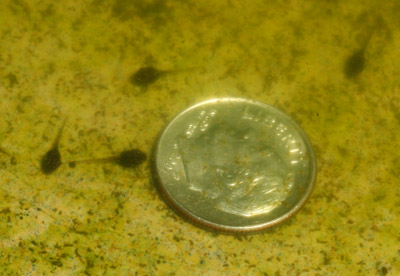 On top of that, a birdbath several meters away was found to be hosting another batch, these remarkably tiny and currently unidentified. The best I can say is that they’re some variety of chorus frog or “peeper,” since they’re the only things I know that would have tadpoles that size. I’m hoping that they can find enough to eat in there, and am topping off the water with fresh from the rain barrels from time to time; I’d move them over into the pond, but I’m not sure that they wouldn’t simply become prey to the other species already present.
On top of that, a birdbath several meters away was found to be hosting another batch, these remarkably tiny and currently unidentified. The best I can say is that they’re some variety of chorus frog or “peeper,” since they’re the only things I know that would have tadpoles that size. I’m hoping that they can find enough to eat in there, and am topping off the water with fresh from the rain barrels from time to time; I’d move them over into the pond, but I’m not sure that they wouldn’t simply become prey to the other species already present.
Of course, I collected a few from each location to do detail shots. I will point out, before we get started, that the bottom substrate in all cases is simply sand, so you can use this to judge relative scale. First off, we’ll look at the tiny ones.

Yes, the two photos above are of the same species. No matter what kind of light falls on them in normal circumstances, they appear simply black, but down at eye level with the macro flash, they become Fab-ulous! I like how the pigment is just patches over a mostly transparent skin, and other angles that I shot show internal organs surprisingly well. But we have plenty more to check out.
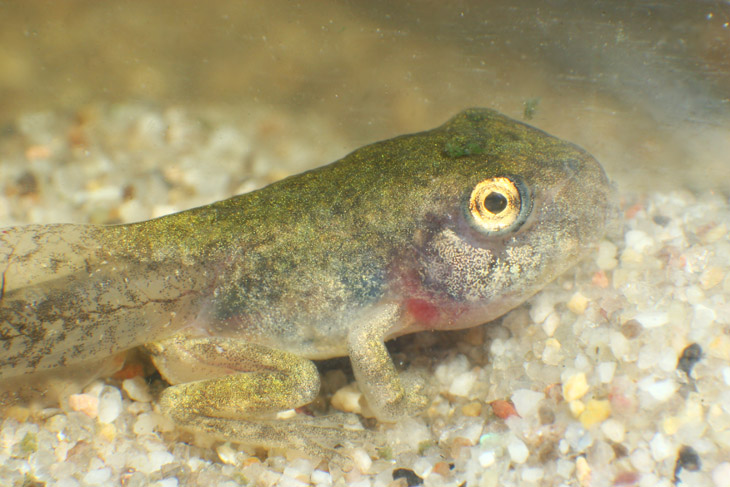
I made it a point to find tadpoles that were showing legs, and the difference in size and development was interesting. Most of the larger ones were showing tiny little hind legs, while the medium-sized tadpoles had much more developed hind legs, and since I was almost certain I’d seen one in there with four, I spent some time sweeping with the net until I scared one up. And it turned out to be even more interesting on close inspection. I’m fairly confident this is a Copes grey treefrog, but at this stage I haven’t enough knowledge of identifying characteristics, if they even exist, to confirm. The interesting bit is when we go to the opposite side.

This is the exact same specimen, and by the way, let me expound slightly. Tadpoles don’t usually sit still for pics, at least until they’ve been in an aquarium for a while, which I wasn’t aiming for. So just getting one posed close enough to the glass to minimize distortion and sediment haze takes a bit of patience, but to then get the same one to turn around and face the other way is even more of a challenge. They have two responses to a gentle nudge: no movement at all, or swimming away desperately. So after sending this one on a circuit of the aquarium several times over, I eventually got it to pause facing in the opposite direction, so I could get photographic evidence of only one leg on this side. And we’ll go in for a minute inspection.
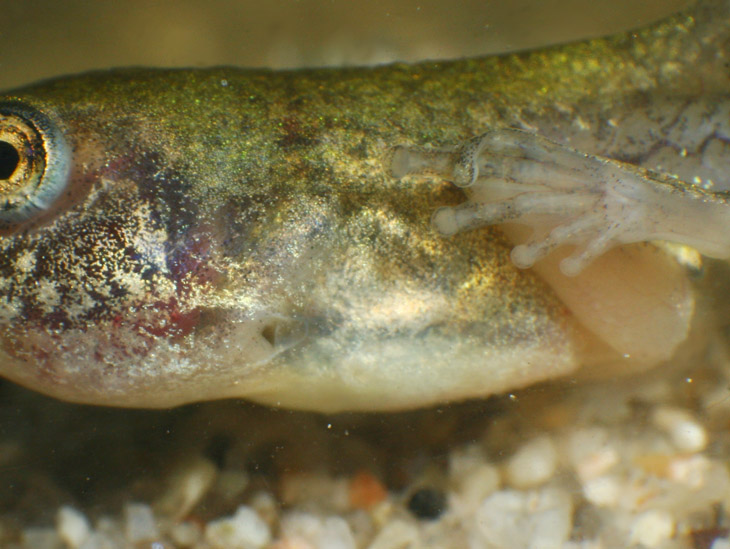
There does, in fact, seem to be a hole there, and I admit it’s easy to believe that something (not me – I was careful) took that limb away from it. However, as it would swim along I would get the unmistakable impression of something under the skin, like someone running around with their arm under their shirt, which was part of the point of getting these photos: I wanted to see if this was visible. The photos don’t seem to give any indication of this, and I wasn’t sure I wasn’t just seeing the edge of the developing jaw or something. So out of curiosity, I retained this particular one for a day just to see what happened. That experiment paid off.
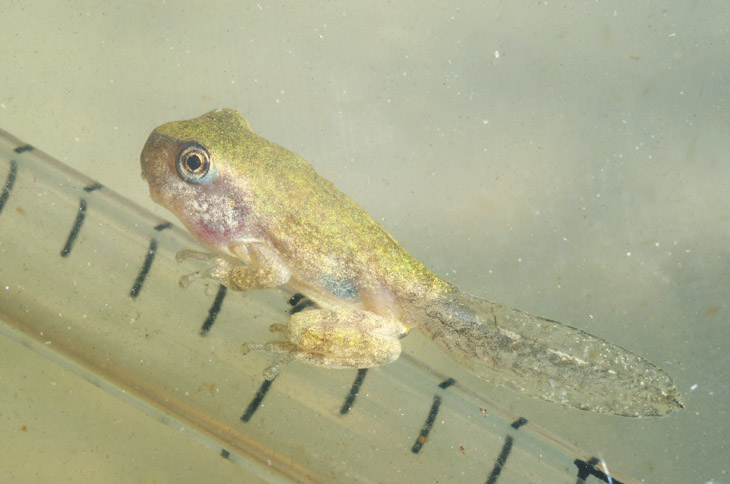
Yep. 30 hours later we have a fully-developed and functional limb there, so I have to surmise that they develop within the body and emerge. I have spent my life yearning for new equipment, like microscopes and macro video capabilities, and now I want an x-ray machine…
The thing that it clings to, by the way, is a small graduated pipette/cylinder about the diameter of a standard pencil (number two of course.) With all four limbs, the tadpole was now quite willing to cling to things, and even take a little jaunt up the side of the aquarium when I was being too annoying.
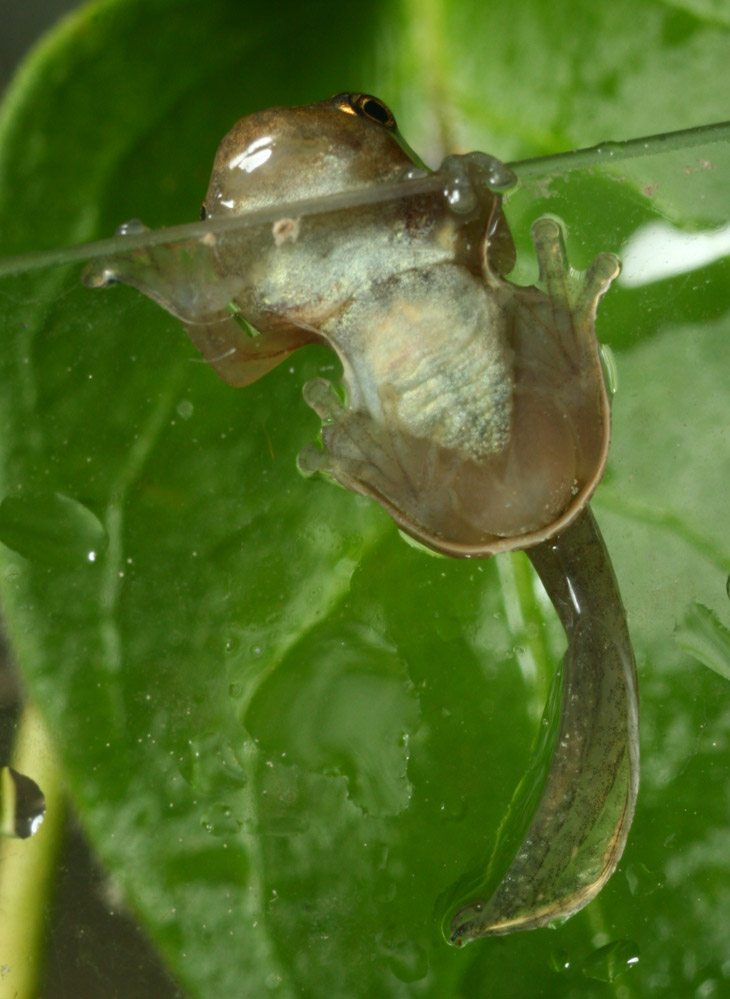
That tail will soon disappear, and the tadpole or frogpole or froglet or whatever you want to call it will venture out onto land. And now I want my x-ray again, to see if the tail actually has a skeletal structure (it certainly looks like it does from the photo further up,) and perhaps get daily radiographs of it disappearing, But for now, let’s take a look at some details that I did get, this pic from one of the green tadpoles several weeks back.
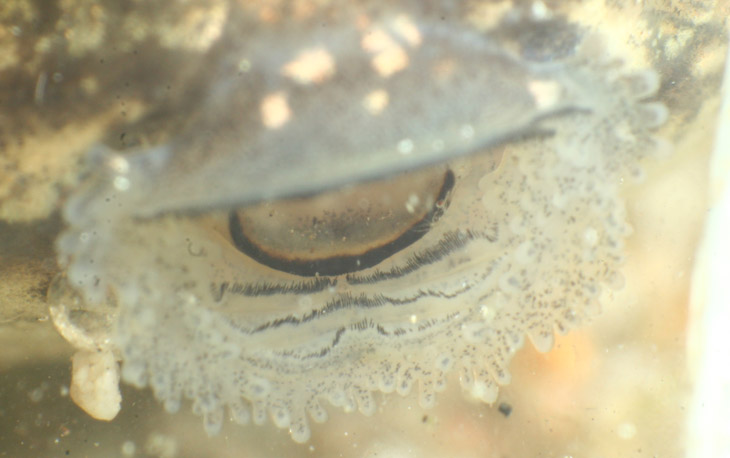
Eewwwwwww! Actually, this is the mouth of a tadpole, and right now I can only offer my speculation, but I’m fairly certain these are just feeling/tasting appendages to help them collect the algae and other stuff that serves as their food. Most time it faces downwards and you can’t see anything at all, but when a tadpole ventures vertically up the glass you can get a peek at something that looks like a pencil-mustache and black lipstick or something. Mouthliner? Whatever – it’s really distinct and more than a little bizarre-looking.
Along with the tadpoles, I collected a few specimens of some aquatic beetle, the same kind we got a glimpse of previously, and was trying for more detail shots. This endeavor was seriously taxing, because the beetles are hyperactive and rarely pause in one spot, and of course they had to be close to the glass. When it happened, it was always for just long enough to start to pin down focus, but ended right before I tripped the shutter. Seriously, I have several empty frames, which isn’t counting all of the times that I realized they’d left and never made the attempt. Eventually, I got some cooperation when a pair of them got frisky – but then others started photobombing, I can only guess attracted by some aspect of active mating.
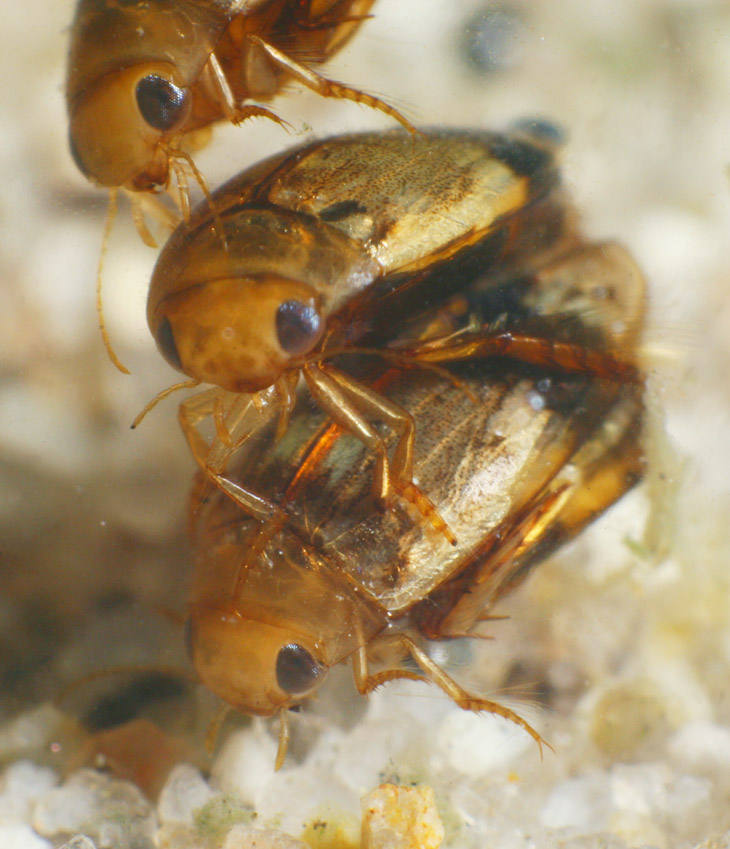
Despite the interference, they completed their tryst and I got my photos, including some fairly detailed shots of genitalia, which I will display upon request as long as you can demonstrate some valid reasoning like being an entomologist or something. You’ll have to answer a test question like what a metasomal tergum is. If you ask me to show you a beetle’s peepee, you’re not getting an answer.
And while at the neighborhood pond the other day, I saw a large collection of some aquatic insect at the water’s edge, but couldn’t see them closely enough to know what they were; not quite the size of a grain of rice. So I collected a few and did some images of them during this session as well. It turns out they were some variety of backswimmer or water boatman, family Corixidae, but as nymphs still difficult to identify. Which is not to say that I didn’t get some nice shots.
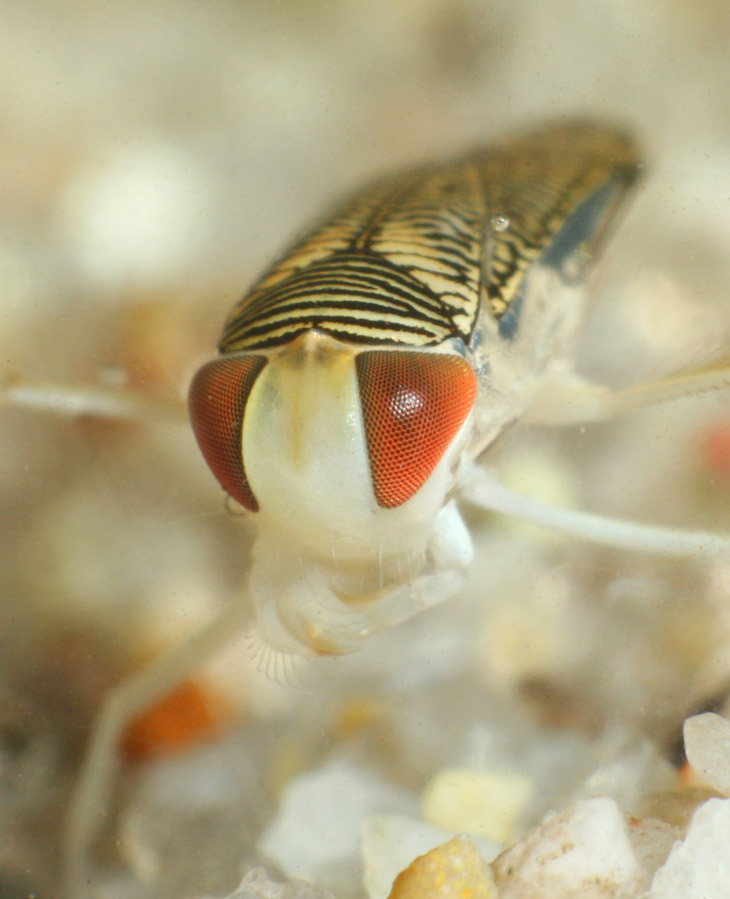
Again, that’s sand down there, and not coarse stuff either – standard beach sand that stays forever in the floor mats of the car. Each one of those eye facets can let through, like, one photon each…
As I returned my photo subjects to the pond later at night, I found a little frog sitting right on the edge as if it had just emerged. Since the tail was almost completely gone I’m going to guess this was just an impression, but of course I captured it for some of its own closeups.
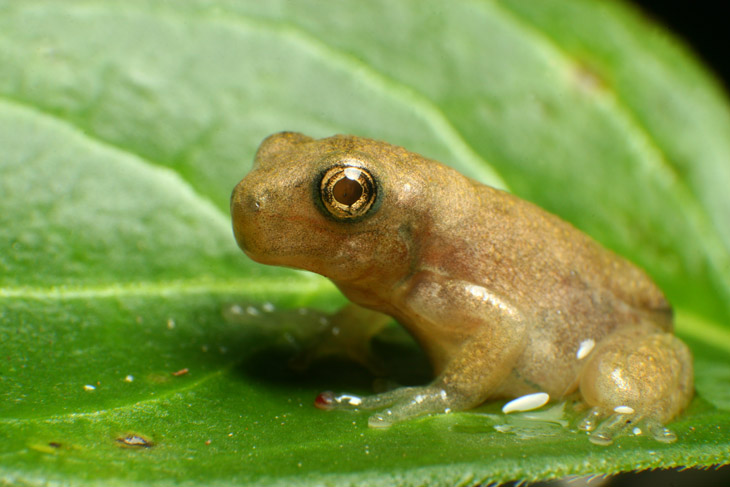
In coloration and size, it was pretty close to my tadpole subject with the emerging leg, and I never really made out any markings that would help identify it, save for some restrained striping on the hind legs and a hint of a broad stripe through the eye, but since it’s obviously a juvenile the identifying characteristics haven’t developed yet, at least as far as my general guide goes. You’re welcome to have a look yourself and see if you can figure it out; I’m leaning towards one of the smaller species of little grass frog, chorus frog, or spring peeper. Here are a few more shots to provide as many traits as possible (while showing off of course.)


Remember, I’m just guessing, from the timing of events, that the majority of tadpoles in the pond are Copes; it’s possible that the larger ones are, but the species that we saw further up is actually something else. I mean, I didn’t camp out at the pond’s edge or set up surveillance cameras to see who was dumping their progeny into the water.
A few days later as I was collecting water from the rainbarrels to soak the plants, I spotted another little spud sitting on a weed right alongside the barrel. For reference, the leaf is about the size of a largish carrot or medium cucumber.

Naturally, I did a quick session with this one as well, who definitely wasn’t thrilled about the camera looming close and repeatedly faced away, often hopping to another leaf. With a lot of scrambling around, I could manage some portrait angles, very briefly.
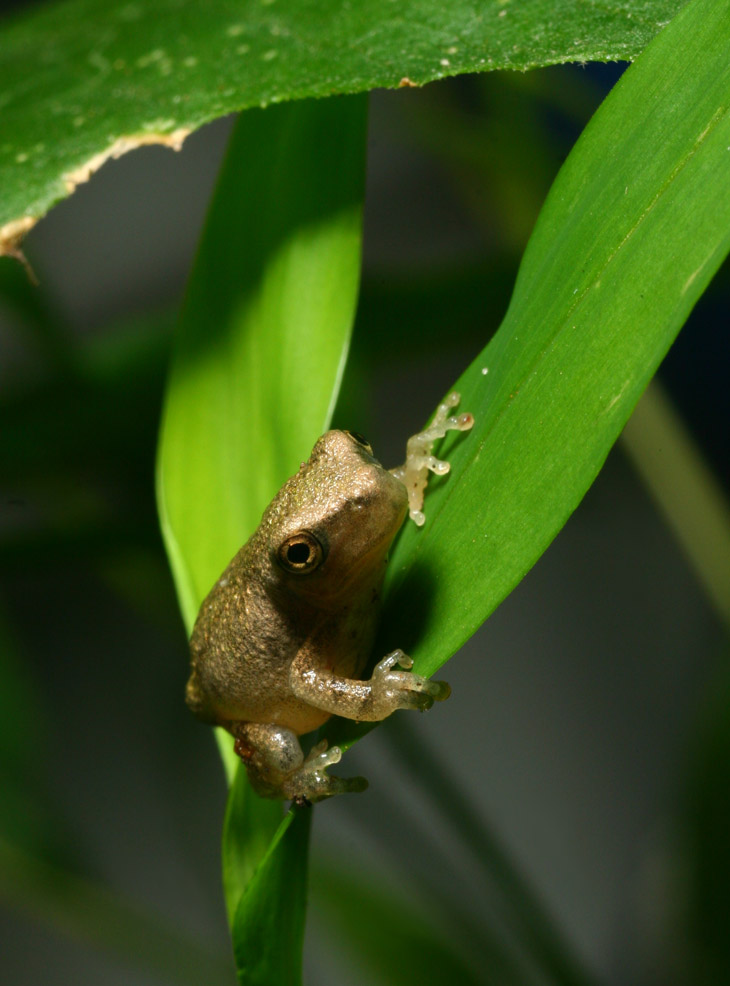
Such an action pose.
And then, for another illustration of scale, I managed a shot of it perched on my middle finger. Since my left hand was in the shot, I couldn’t use it to close down the aperture on the mounted Mamiya 80mm macro, so we’re talking very short depth here at f4, but still enough to give the right impression.
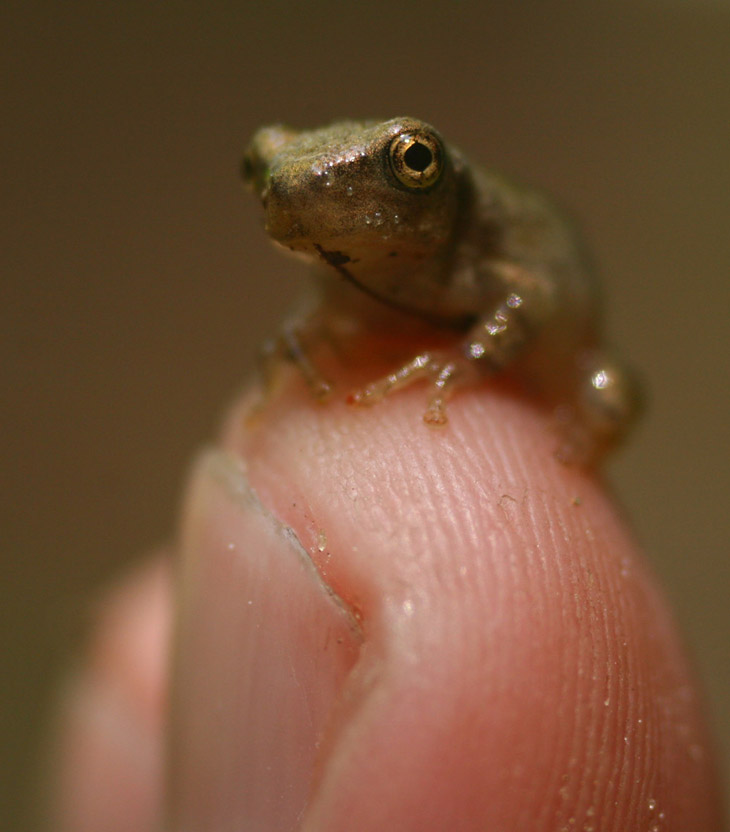
Remember, that’s my middle finger, not thumb. But it was as I was editing this shot that I spotted a key detail: that red toe tip. And realized that this was the same frog that I’d shot two days before, having collected and released it at the pond a few meters away – scroll up to that left-side portrait under the water boatman pic to compare. The frog was probably getting pretty annoyed with me by this point.



















































